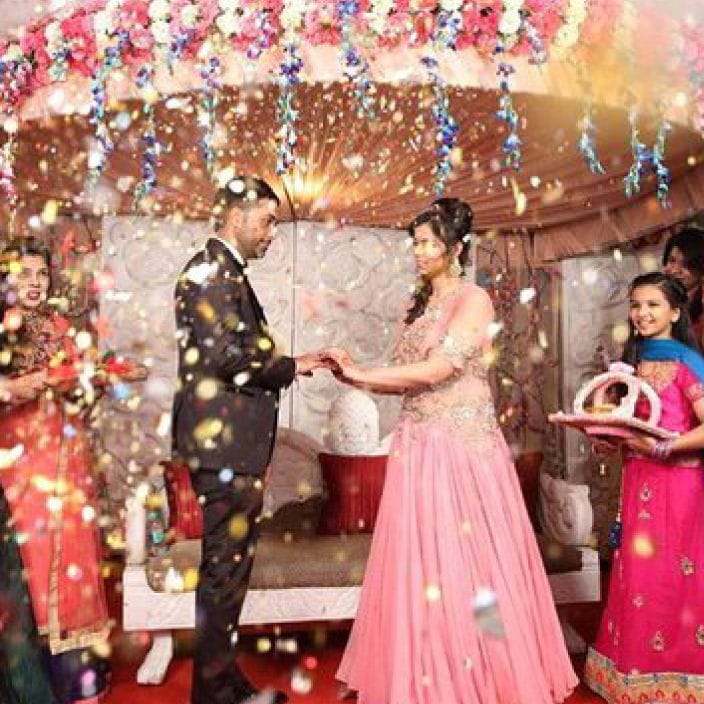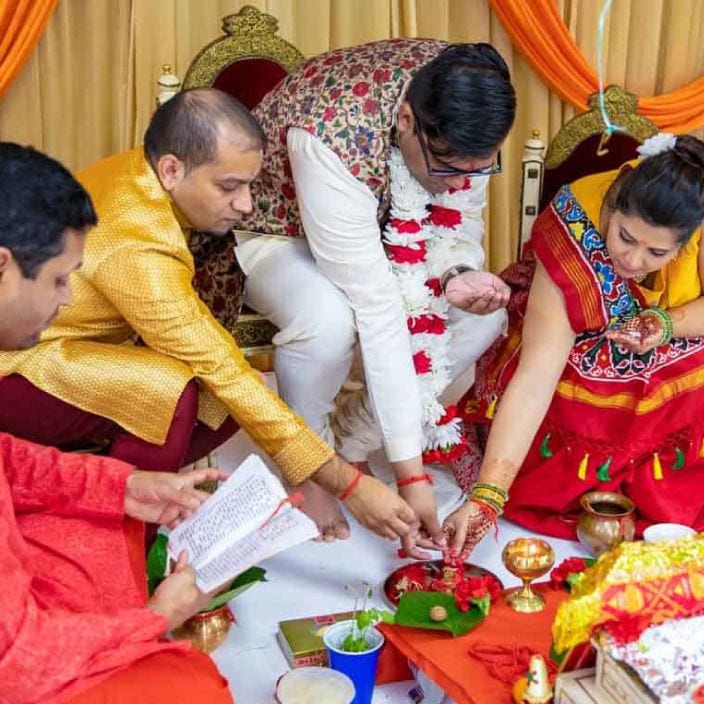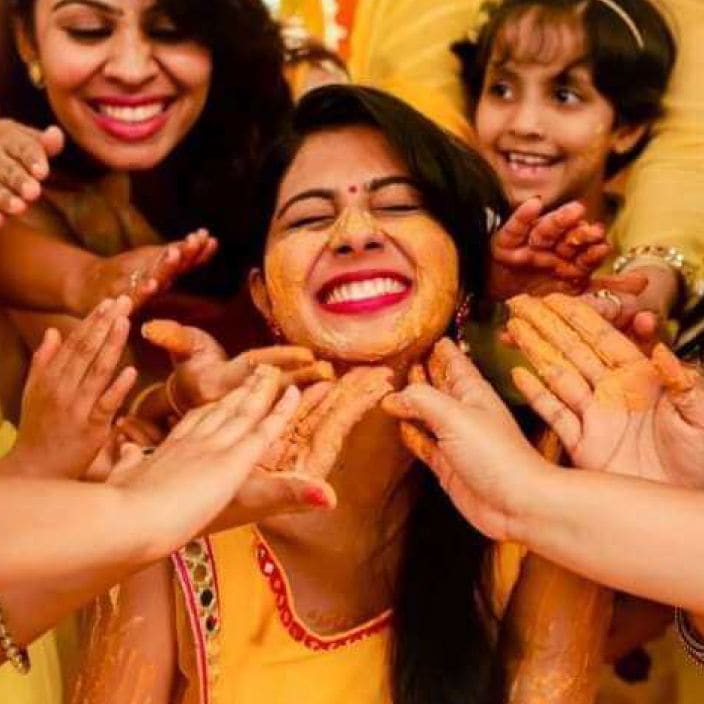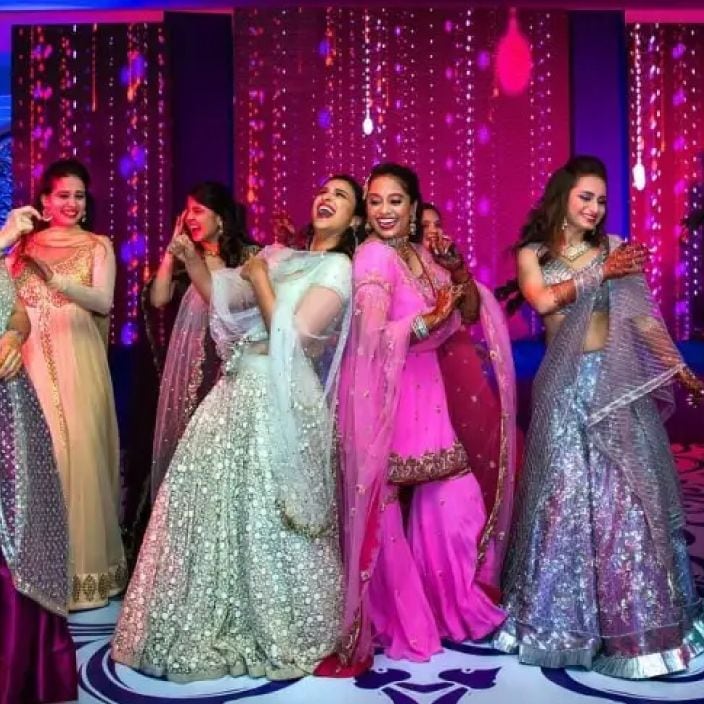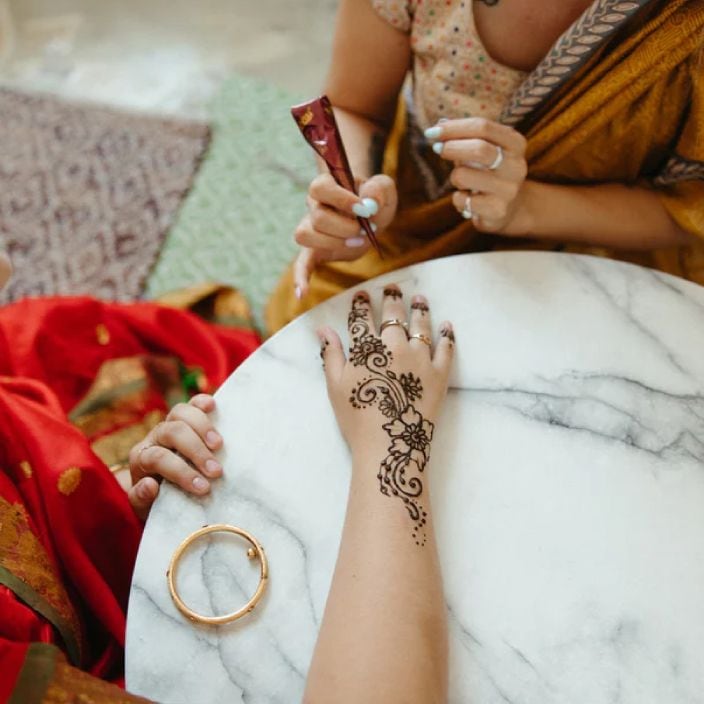For best prices and early deliveries, WhatsApp us at. 918488070070
Haryana
A wedding held in the Northern Indian state of Haryana signifies the coming together of two individuals and families. Overflowing with ceremonies and celebrations, every wedding reflects the state's cultural richness. A wedding in Haryana begins at least a month before the wedding day and has colourful and eventful pre-wedding, wedding, and post-wedding ceremonies. Every wedding in Haryana reflects a healthy legacy of culture dating back to Vedic times. Rituals like Pithi Lagana (applying turmeric paste on the bride), Bhat Nyotna (bride’s/groom’s mother inviting her brother to bless her child), Satphere or Saptapadi (taking seven sacred vows around the fire), the Vidaai (bidding the bride farewell) and Griha Pravesh (groom’s mother welcoming the bride to her new home) which have existed since Vedic times, emphasise the continuity of cultural heritage. In addition, rituals like Jaimala (exchange of wedding garlands), Ghara Gharoli (bringing well water in an earthen pot), and Kalire (bride shaking kalire tied on her bangles over the heads of unmarried girls) have deep historical significance rooted in ancient Hindu customs. Haryana has a strong tradition of joint families. Thus, weddings are a big gathering of family members, extended families, and the broader community. Many women join in to sing bhajans (spiritual songs), Jakdi, or folk songs like Ragini and to perform traditional dances like Ghoomar.
Tracing the Traditions
A wedding in Haryana encapsulates the age-old culture with deep-rooted values, beliefs, and traditions. While the diversity of rituals and customs across different regions vary slightly, they all have pre-wedding, wedding, and post-wedding rituals.
The pre-wedding ritual begins with the Sagai, or engagement ceremony. It is the official agreement of the marriage where the couple exchange rings. Next is the Bhat Niyotna and Ban Baithana ceremony, held one month before the wedding. Here, the bride and the groom’s maternal uncles arrive with the Bhaat (lehenga or sherwani, jewellery, sweets, and cash gifts) as a gesture of goodwill and respect from the maternal side to mark the start of wedding celebrations. This is followed by Aguthi Pahanna, a symbolic ritual where the bride and groom are adorned with sacred threads or ornaments to signify the sanctity of the upcoming union. The Chak Puja, a ceremony dedicated to the preparation of grains and spices, is performed to seek blessings for abundance and prosperity in the couple's married life. This ceremony is followed by Pithi Lagana, where ghee, turmeric, and crushed barley are rubbed on the bride’s skin, making it glow for her big day. Another interesting ritual is Banori, in which Banori, a sweet dish, is prepared and served to the bride and groom at the priest’s residence, honouring and respecting the priest’s role in the wedding. As the wedding day approaches, the Ratijka ritual is observed. This is an overnight celebration involving songs and dances performed by family members and friends.
Next are the Mehndi (henna) ceremony for the bride and the Khichai custom for the groom, where family members and neighbours come together to cook Khidchi for the gathering. Both are the last pre-wedding ceremonies performed two or three days before the wedding day.
On the wedding day, the groom leaves his home for the wedding venue in a procession. This is known as Barat Nikasi. What follows are rituals like Ganesh Sthapana, Chawal Chahana, Seha, Toran, Varmala, Hathlewa, Gajoa, Kanya Dan, and the quintessential Satphere or Saptapadi. The last of the wedding ceremonies is Vidai, which represents her departure from her parent's home.
There are more traditional ceremonies post the wedding day rituals. These post-wedding Haryanvi traditions include Kanwar Kelava, which involves offering a grand feast. Other post-wedding traditions include Rangbari, Vidai, Griha Pravesh, Dwar Rukai, and Pag Phera.
Wedding Attire
The overall attire at a Haryanvi wedding is a mix of tradition and cultural symbolism. The bride may wear a lehenga choli. It is a long, flowy skirt and blouse with a chunni, a type of dupatta draped over the head, symbolising modesty and respect. It is mostly red, maroon, or pink and adorned with heavy gold or silver embroidery, zari work, or gotapatti. In some regions, women may wear a Salwar Kameez, Anarkali suit, or Ghagra-choli. The bride wears traditional gold and Kundan jewellery that includes pieces like a Rani haar (multi-strand necklace), Jhumkas (earrings), Maang tikka (forehead ornament), nath (nose ring), Chooda, Kangan (gold bangles), and Kalire (bangles with decorative hangings) and Payal (anklets). Instead of the Rani Haar, some brides from the Jat community wear the Kathla Haar and Bania community gold Malas with large pendants.
A Haryanvi groom wears a heavily embroidered Sherwani or Achkan often paired with a kurta and churidar or dhoti. Wedding Sherwanis and Achkans are usually in pastel shades like cream, gold, or bright shades of red and maroon. Sometimes, the groom drapes a stole or dupatta over one shoulder. The look is completed with Mojaris or juttis (traditional footwear), a Pagdi (turban) adorned with a Kalgi (a decorative brooch), and a Sehra (a veil of flowers or beads) that covers his face. The Safa, a specific type of turban, is often crafted meticulously, highlighting its artisanal value.
Traditional Cuisine
The cuisine at a Haryana wedding consists of locally sourced agricultural produce. Aloo Rasedar, Kadhi Pakora, Sarson ka Saag, Chole, Makki di Roti, Bajra Roti, Jeera Rice, Besan Masala Rotis, Bajra Khichdi, and Bajra rotis form the main course. Aloo Paratha is another popular item that guests relish during these occasions. Also, accompaniments like Dahi, Chutney, Desi Ghee, and Aachar are a part of the meal.
Also, some typical accompaniments like Kachori, Pakoras, and Bhutte Kees and beverages like Lassi, Thandaii, and Chaas are served at Haryanvi weddings. Lastly, since no Indian wedding is complete without sweets representing happiness, the main desserts served are Churma, Ghevar, Balushahi, Rabri, Halwa, and Kheer.
Cultural Decor
Cultural wedding decor in Haryana is a visually stunning treat blending rustic designs and bright colours. The entrance and mandap are traditionally decorated with Torans made from marigold flowers, beads, and mango leaves. Sometimes, jasmine, roses, lilies and even lotus flowers are used. Colourful fabric drapes in red, yellow, green, and orange hung from the mandap canopy add a festive touch.
Earthen Lamps (Diyas), brass or copper urns, woven baskets, wooden carvings, puppets, Sanjhi (paper stencils), murals and decorated bullock carts are used as props. Elaborate rangoli designs using powders, rice, flowers, and grains decorate the floor of the Mandap or venue entrance. In the evening, string lights, fairy lights, and paper lanterns add vibrancy to the decor.
